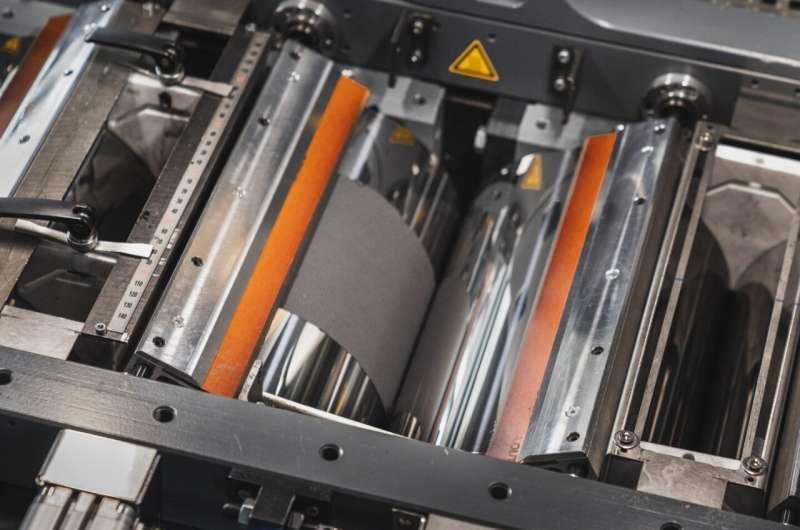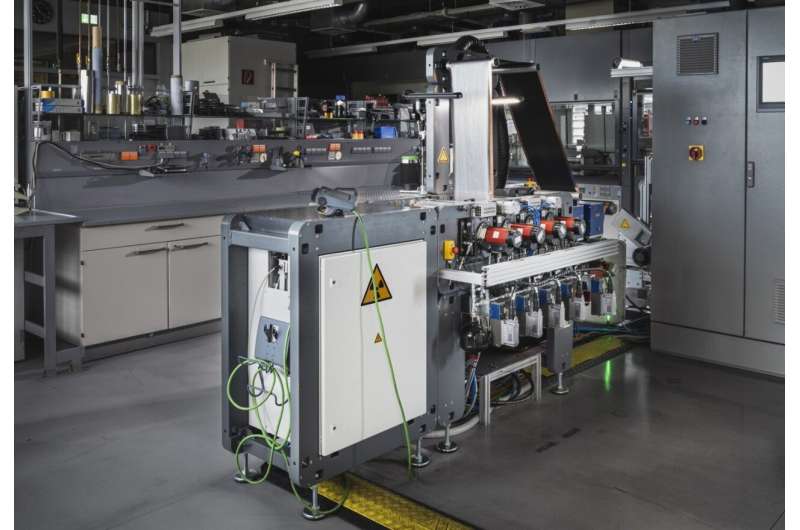Environmentally friendly manufacture of battery electrodes

Conventional processes for manufacturing battery electrodes involve mostly toxic solvents and require a lot of space and energy. This is not the case with DRYtraec—a new dry-coating process developed by the Fraunhofer Institute for Material and Beam Technology IWS. The technology is environmentally friendly and cost effective and can be used on a large scale, giving it the potential to revolutionize the manufacturing of battery electrodes.
The Federal Ministry for Economic Affairs and Energy (BMWi) predicts that Germany will consume around 655 terawatt hours in the year 2030—an increase of almost 20 percent compared to today. Prognos AG carried out a corresponding study on behalf of the ministry. This figure is an initial estimate; final results are expected to be available in the fall. However, it is clear that society’s overall energy demand is continuously increasing. The fast-growing electromobility sector is therefore looking for new ways to reduce the energy required to manufacture batteries and thus to design them to be as cost effective and environmentally friendly as possible. DRYtraec is a promising solution developed by an interdisciplinary research team at Fraunhofer IWS in Dresden that focuses on the production of the battery electrodes.
A key component of any battery, electrodes normally consist of a metal foil with a thin coating. This coating contains the active components that are responsible for storing energy. “The conventional coating process uses a wet chemical method that applies what is known as slurry,” explains Dr. Benjamin Schumm, Group Manager for Chemical Coating Technologies at Fraunhofer IWS. The active material, conductive carbon and binders are dispersed in a solvent to make a kind of paste, which is initially applied to the metal foil to form a wet coating. “Extremely large machines with very long drying tracks are needed to ensure that the solvent will evaporate afterward. With DRYtraec, we can design this process more efficiently.”
Special binder and shear forces from rotating rollers
The new coating process essentially uses similar raw materials as in the slurry process. The dry coating technology developed at Fraunhofer IWS works without solvents, but instead uses a special binder. Together, the materials form a dry mixture that is fed into a calender gap—a gap between two rollers rotating in opposite directions. The crucial detail is that one of the rollers must be turning faster than the other. This induces a shear force, which ensures that the binder forms thread-like networks known as fibrils.
“Imagine it as a spider’s web that mechanically embeds the particles,” says Schumm. The pressure and motion form a fine film on the faster-rotating roller. This film is then transferred in a second calender gap onto a current collector foil. This allows both sides to be coated simultaneously without significant additional work. In the final step, the resulting coil is cut to the required size and the individual parts are stacked as appropriate in order to produce the finished battery cell.
Success thanks to combined expertise in chemistry and manufacturing engineering
DRYtraec therefore has clear ecological and economic advantages over existing battery electrode coating processes. Removing toxic solvents and long, energy-intensive drying machines from the process benefits the environment. The new process also accelerates production and requires only one-third of the equipment space of a conventional solution, saving costs in number of ways. In Schumm’s view, the success of the DRYtraec process comes primarily from the diversity of expertise in the research team at Fraunhofer IWS. Colleagues with a background in chemistry worked on the opti-mum powder mixture, but experts in manufacturing engineering, for example, developed equipment that prevents the dry film from ever being self-supporting, ensuring that it remains stable.

A wide range of possible applications
The first prototype DRYtraec systems were commissioned as part of the “DryProTex” funding project. This project demonstrated that it is possible to manufacture electrodes continuously, regardless of the type of battery: “The range of possible uses for the technology is not limited to a particular cell chemistry,” Schumm points out. “It could equally be used on lithium-ion cells as on lithium-sulfur or sodium-ion cells. We are even looking at solid-state batteries. These will be increasingly important in the future, but the materials cannot tolerate wet chemical processing. Thus, DRYtraec allows us to offer a very promising solution to this problem.”
The industry is showing a lot of interest in the process. Discussions are currently underway with several automobile and cell manufacturers to plan the construction of a number of pilot systems. Beyond manufacturing electrodes with DRYtraec, the researchers at Fraunhofer IWS are engaged in many other research projects to examine the entire battery cell development process chain. By doing so, they are playing a key role in shaping the future of the battery.
Citation:
Environmentally friendly manufacture of battery electrodes (2021, September 1)
retrieved 1 September 2021
from https://techxplore.com/news/2021-09-environmentally-friendly-battery-electrodes.html
This document is subject to copyright. Apart from any fair dealing for the purpose of private study or research, no
part may be reproduced without the written permission. The content is provided for information purposes only.
For all the latest Technology News Click Here
For the latest news and updates, follow us on Google News.
